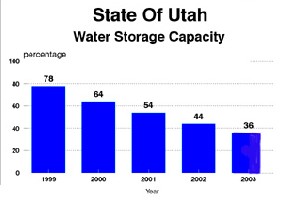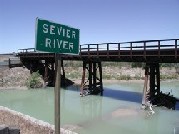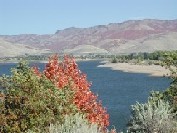Utah's Water Reservoir Levels Continue to Decline
Fifth year of drought reduces state's stored water supply to 36 pecent of capacity.
October 15, 2003
LeRoy W. Hooton, Jr.
|
The state's reservoirs have lost nearly 3.5 million acre-feet of water over the past 5-years. The Sevier Basin is the most critical with only 2 percent of its storage remaining, followed by the Bear River with 11 percent. The Uintah Basin has the highest storage volume with 66 percent. "Utah watersheds are low and conservation will be key to next year's water supply again," said Julander. "On the bright side, this is exactly what reservoirs are for and water managers have done an outstanding job of management over the past few years."
|
Water storage in Bear Lake is only about 11 percent of normal. Full, this large northern lake situated on the Idaho border holds 1.4 million acre-feet of water. On October 1, the volume was reduced to 152,000 acre-feet. Utah Water Users Association Executive Director Carly B. Burton said that the lake is at its lowest level since 1936. "[The] accumulated runoff for the past 4 years is only one-fourth the annual average," said Burton at a recent Association board meeting. Adding, "[The] flow below Cutler Power Plant is the lowest on record for the past 114 years."
|
Even the larger watershed drainages are losing water storage volumes. Flaming Gorge is only 30 percent full. Likewise Lake Powell is down to 50 percent capacity, affecting the local recreation economy and stirring evironmentalist's desire to drain the reservoir. There is growing concern all along the Colorado River system about the effects of the current drought.
Fortunately water storage in the larger populated areas of Utah and Salt Lake Counties located in the Provo drainage is 58 percent. Jordanelle Reservoir bolsters the Provo drainage with 251,000 acre-feet of water remaining in storage (78 percent). This Central Utah Project feature has maintained this volume of water during the drought period. Carry-over water in Deer Creek Reservoir allocated to the Metropolitan Water District of Salt Lake & Sandy amounts to about 25,000 acre-feet. On October 1, Little Dell located east of Salt Lake City held 14,350 acre-feet of water. These two stored water supplies enhance Salt Lake City's water supply for next year in the event the drought continues.
|
In southern Utah, fast growing Washington County actually improved it's water year-end storage over last year. Nevertheless, the southwest drainage storage is down to 38 percent. Water conservation and summer monsoon storms helped with added precipitation to the region.



